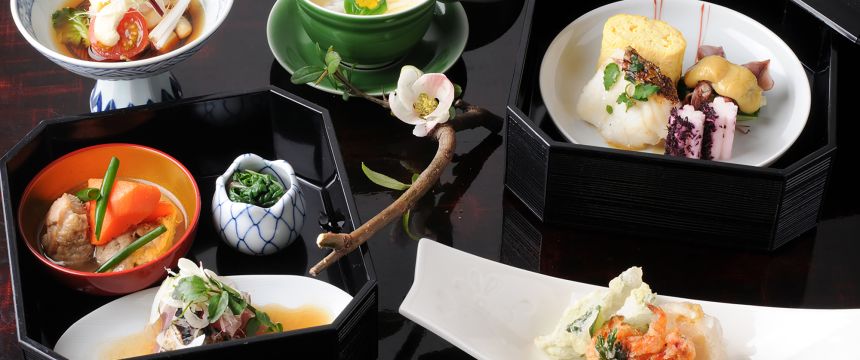Tottori City, Tottori Prefecture - Chugoku

Venture to the southwest of Honshu, the largest island in the Japanese archipelago, with Tottori Prefecture as your destination. Located on the Sea of Japan, this prefecture is known for its spectacular sand dunes, stunning coastline, and of course, its exceptionally delicious seafood.
Tottori offers bounty from the sea year-round, but if squid is your seafood of choice, go there in the summer months. The Tottori squid season begins in early summer and runs until late fall, peaking in July and August. On summer nights, the sea is dotted with bright lights that lure the squid to fishing boats—and their fate. If squid is the taste of summer, then these lights bobbing on the pitch-black sea are the scenery of summer. Steer your course toward the shores of southwestern Honshu, and discover the joys of a Tottori summer.
Discover Shiroika, the Legendary White Squid of Tottori

Start your quest for squid in Karo, a neighborhood in the city of Tottori and the location of one of Tottori’s foremost fishing harbors. There, you’ll find Karoichi Fish Market, where just-caught seafood fills the stalls and is sold at reasonable prices.
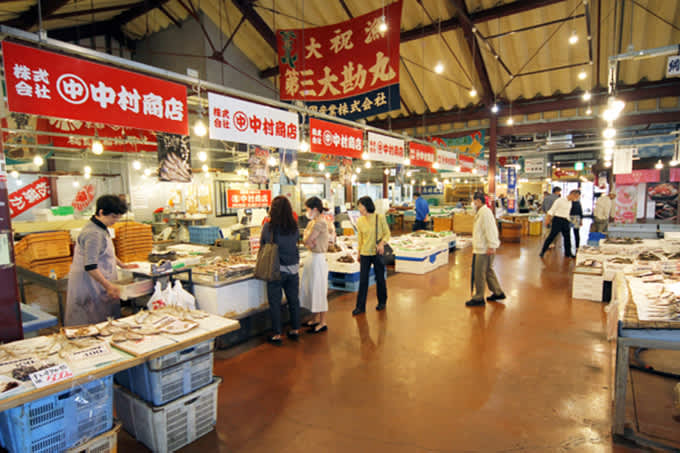
Before settling on a spot to eat, have a look around the market and enjoy the hustle and bustle of shoppers and fishmongers discussing the day’s catch. You might even notice the fishmongers testing and affirming the freshness of the squid by poking it with their fingers. Sneak a peek at the white squid being handled, and notice red spots appear where fingers have applied pressure.

This is shiroika (white squid), which is the Tottori name for pole-fished swordtip squid. When swimming, shiroika are almost transparent. After they’re caught, however, they turn red, which might explain why in Kanto, the region of Japan that includes Tokyo and its surrounding prefectures, the same squid is called akaika (red squid).

By the time they’re on display at the market, however, they have changed color again, this time to an opaque white. But the red color is still there beneath the surface, just waiting for a fishmonger to make it visible with the poke of a finger.
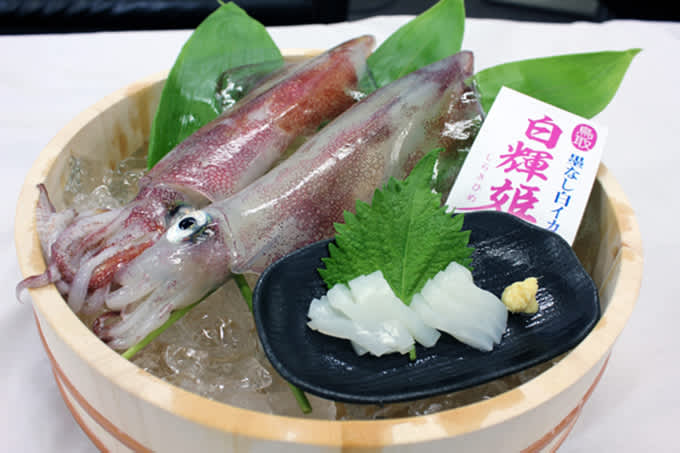
Squid may be delightful to eat, but a squid’s ink sac can make preparing it a messy chore. This is why the Tottori Seafood Promotion Council came up with idea of selling the local squid with the ink sac removed. Calling this shirakihime, the council hopes that the easy-to-prepare squid, available in Tottori supermarkets and department stores outside of the prefecture, will help to increase sales and the name recognition of this local delicacy.
Enjoy Squid So Fresh It Dances on the Plate
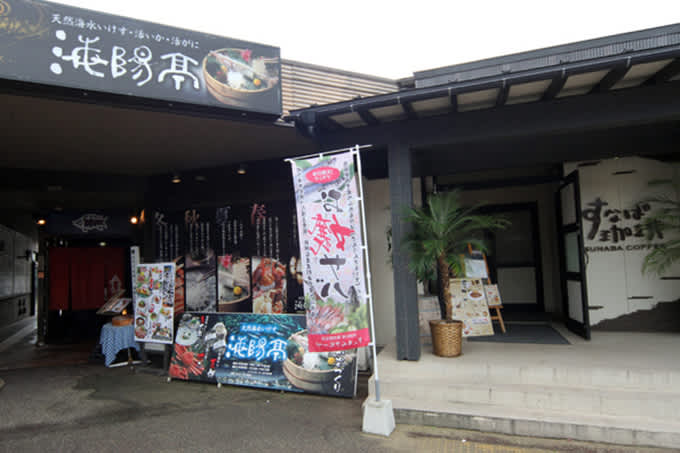
Make your way to Tenen Kaisui Ikesu Kaiyou-tei, located next door to the market, for the freshest squid around. The restaurant serves sugata-zukuri, which is seafood—shiroika in this case—prepared and then served in a form that resembles its shape when it was alive.

Enter the shop and find a hexagonal table with a large fish tank in the middle. Inside the tank, nearly translucent shiroika swim around with vigor. Order shiroika no sugata-zukuri, and the shop staff will remove a squid from the tank with a large net. This must be done with care, or the squid will panic and release ink into the water, staining the tank and weakening the other squid.

Preparing squid as sugata-zukuri is no easy task, but the chefs are equipped with great skill and a sharp knife. You’re bound to be left in awe at the masterpiece that arrives at your table.

Squeeze a dash of lemon juice on the squid arms, and you’ll be treated to a little dance. The squid is so fresh, it can still be stimulated.
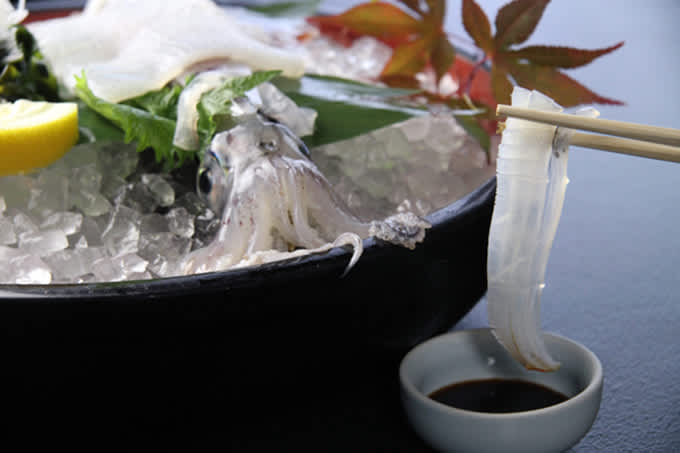
Delight in the satisfying crunch of the squid, and notice how the flavor and texture—and even the color—change slightly over the course of the meal.

Once you have finished eating the sliced squid, you’ll be asked how you would like the arms prepared—deep-fried as tempura or grilled with salt. Enjoy the finale of your meal, and marvel at the many flavors you have just discovered in a single squid.
Uncover the Secrets Hiding in a Simple Squid Bowl

Three minutes by car from Karoichi will bring you to Karo Port, where squid boats are moored during the day and the Karo Shiroika Festival is held in mid-July. Facing the port is Mikaku no Oyado Yamadaya, an inn established in 1723 and most recently rebuilt in 1993.

Drop by Yamadaya for lunch—dinner is restricted to overnight guests—and order shiroika don, a squid bowl like no other. Though the building has an unassuming appearance, treasures for your taste buds lie within.

Thinly sliced shiroika sashimi and Tottori sand-dune yams lie on top of vinegared rice. Served with shredded ginger and nori, the contents of the bowl are almost all white. It may look plain, but don’t judge this book by its cover.
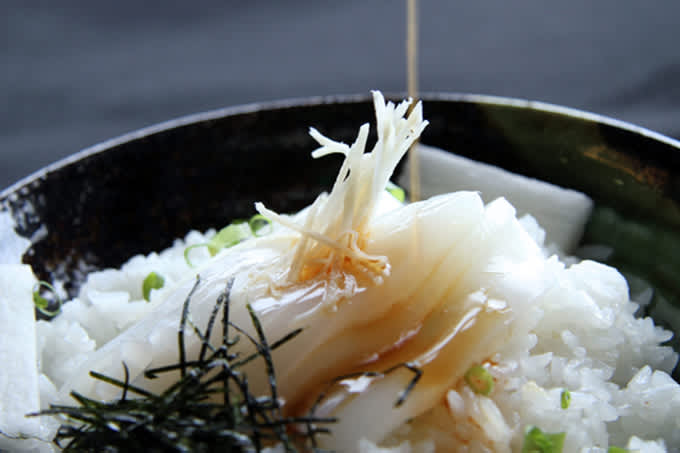
First, splash the squid with dashi-flavored shoyu, and enjoy a bite of squid with ginger. The shoyu—which isn’t as sweet as most sashimi shoyu—and the ginger draw out the sweetness in the squid.
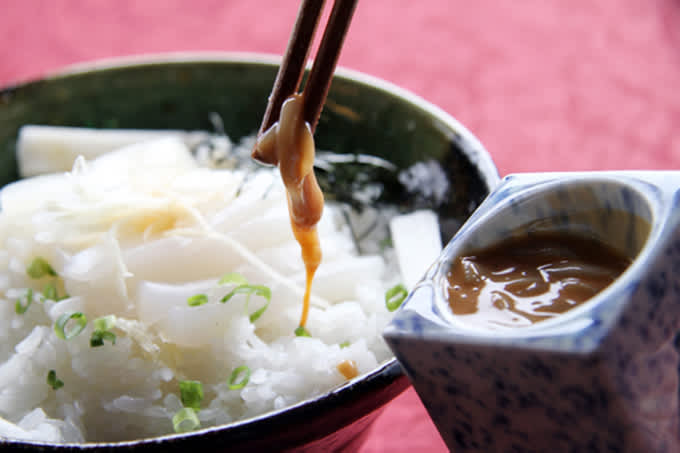
After a few bites, add shiokara, a paste made from salted, fermented squid, to the bowl for a change in flavor. In one bowl, you have thus enjoyed two flavors. But wait—there’s more!

Dip your chopsticks deep into your rice and give it a stir. Hidden inside is a local treat known as uruyaki. Teriyaki-broiled squid legs and internal organs seasoned with shoyu and mirin, uruyaki is fisherman’s cuisine that has been passed down for generations. It’s the third spin on your seemingly simple squid bowl, and a delicious note to end on.

Travel to Tottori and dive into a world of delectable squid. As you savor the many ways shiroika is served, marvel at its delicate beauty, subtle sweetness, and satisfying texture. At night, admire the boat lights bright against the dark sky and sea, and enjoy all that summer in Tottori has to offer.
Contact Information
Karoichi Fish Market
3-27-1 Karocho-nishi, Tottori, Tottori Prefecture 680-0908
Tenen Kaisui Ikesu Kaiyou-tei
3-27-1 Karocho-nishi, Tottori, Tottori Prefecture 680-0908
Mikaku no Oyado Yamadaya
1-5-36 Karocho-kita, Tottori, Tottori Prefecture 680-0907
How to Get There
Tottori Prefecture is located on the Sea of Japan in southwestern Honshu. The capital city, Tottori, can be reached by direct flight from Tokyo to Tottori Sand Dunes Conan Airport. From the airport, the Karo area of the city can be reached by bus in approximately ten minutes.
Recommended Itineraries
A trip to Tottori can’t be considered complete without a visit to Tottori Sand Dunes. Located in San’in Coast National Park, the dunes are the largest in Japan. Check out the Sand Museum to learn more about the dunes and to see incredible sand creations before heading out on your adventures. Activities at the dunes include camel rides, hang gliding, cycling, and sandboarding.
Related Links
Tottori City Tourist Information (English)
Tottori Prefectural Government Tourism and Exchange Bureau (English)
Karoichi Fish Market (Japanese)
Tenen Kaisui Ikesu Kaiyou-tei (Japanese)
Mikaku no Oyado Yamadaya (English)
Tottori City & Around (English)
Map
Featured Cuisine
Shiroika (white squid), is a pole-fished swordtip squid that is considered a specialty of Tottori. The squid is in season from early summer to late fall and is served several ways, including as sashimi and tempura. For an incredibly fresh treat, try sugata-zukuri shiroika, which is raw squid expertly prepared and served in the shape of a living squid.
-
Author
Author: Helen
Helen hails from a small town in Central Canada. Shortly after completing an honors degree in history, a desire to study karate in its birthplace drew her to Japan. Since arriving in 2006, she has earned her second dan in Goju-ryu karate, fallen head-first into Japanese culture by way of cross-cultural marriage, and written about Japan for a variety of publications. She loves traveling by Shinkansen, curling up under a heated kotatsu blanket, and eating anything with mochi.
All information is correct as of the time of writing.
Please check for the latest information before you travel.





















































